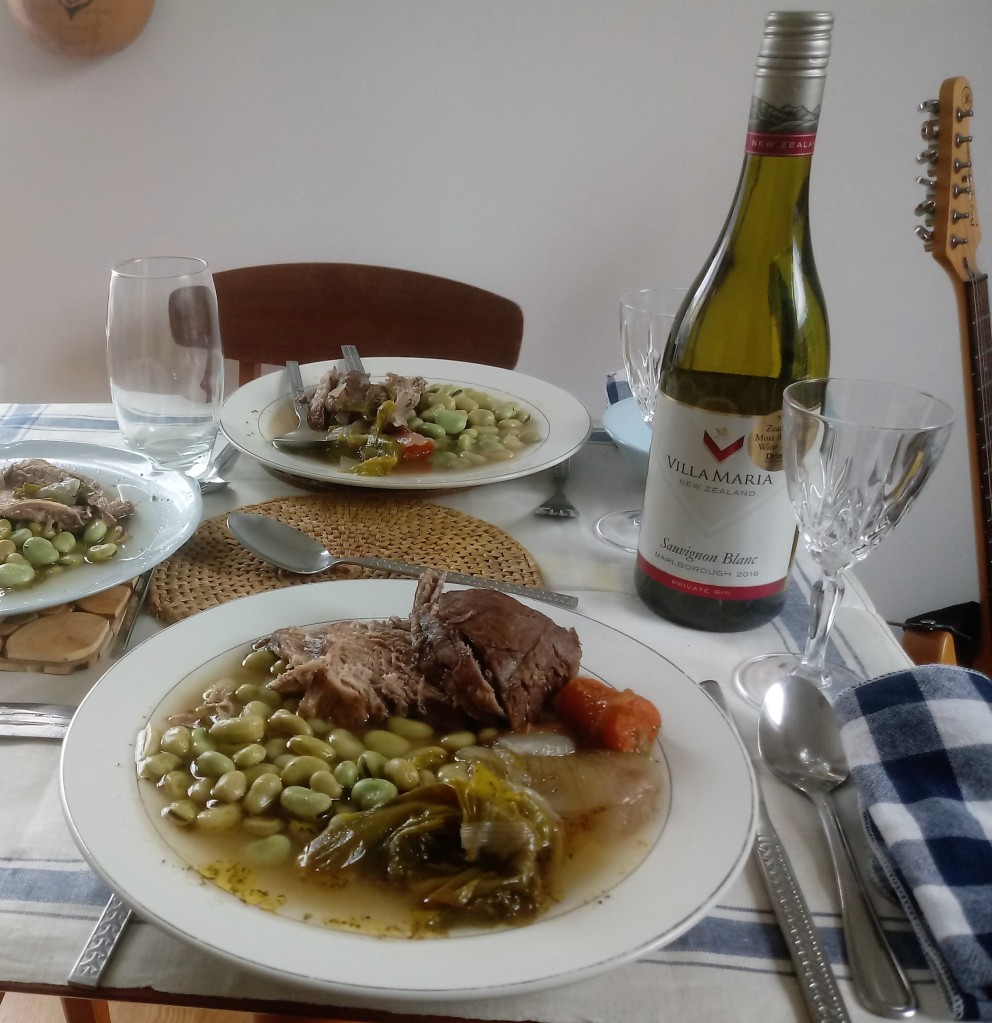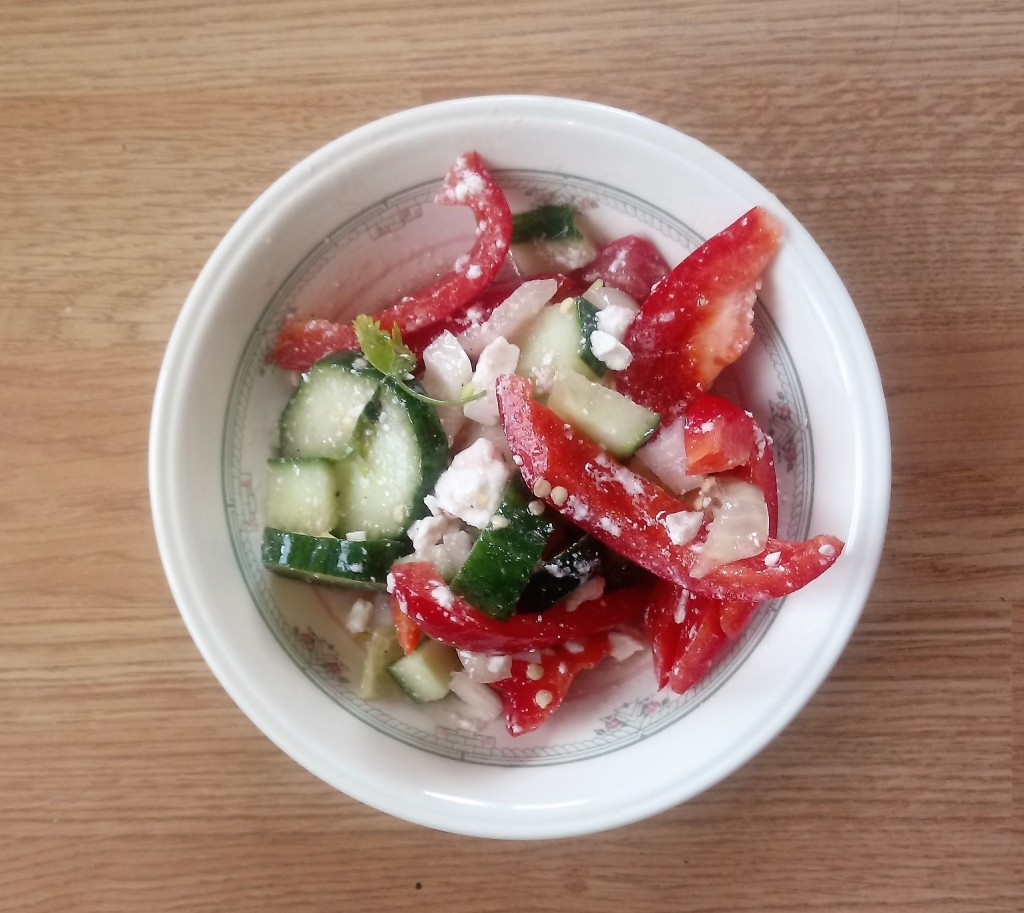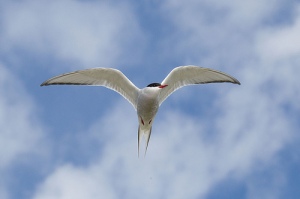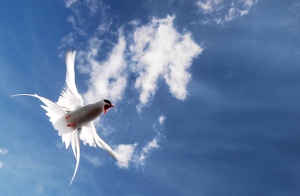
space
What is it we’re starting with? Luxembourg’s Judd mat gaardebounen is smoked pork collar in a herby broad bean stew.
Go on – hit me with a Luxembourgish conservation fact. While Luxembourg is Europe’s second smallest country, it has 271 protected areas – more than one per 10km2. In fact, over half the country is covered by protected areas.
Recipe: Geräucherter Schweinenacken mit Saubohnen on Chefkoch.
Substitutions: Ground cloves instead of whole cloves.
Cooking notes: I first served this to guests with unsmoked pork, only to get a complaint about a lack of authenticity. In light of such damning criticism (well, it was more of a gentle ribbing), I decided to make a second version – this time with home-smoked meat. Having found a handy guide to hob-smoking and adapted it for my own kitchen, I gathered local pine, rowan and cherry twigs and set to work. The results were worthwhile, and the process was an adventure in itself. I would, though, emphasise the need to line your pan VERY WELL with tinfoil… unless you want a lot of cleaning afterwards.
Makes: 7 portions
Carbs: 18g per portion (thus 125g in total)
Rating: 73.

space
What’s next? Koupepia me Ampelofylla, stuffed vine leaves from Cyprus. Also featuring rice and a lot of tomato.
Cyprus still has a massive problem with illegal songbird trapping (and eating), but international conservation efforts are making headway. The number of birds caught this way is down from over 10,000,000 in the 1990s to “just” 345,000 last year. There’s also some good work going on in turtle conservation – another area close to my heart – so I have to give the Society for the Protection of Turtles in North Cyprus a shout-out.
Recipe: Koupepia me ampelofylla (Cypriot Stuffed Grape Leaves) by Ivy Liacopoulou at Kopiaste.
Substitutions: I used more fresh mint than dried.
Cooking notes: Stuffing the leaves is a rather delicate technique, and leaf size was rather variable. I found myself having to spread my filling across more vine leaves so as not to burst them.
Makes: 4 to 5 portions
Carbs: 21g carbs for a one-person portion of 18 leaves with 150g yoghurt. 66g carbs for the whole batch of stuffed leaves – so just over 1g per leaf, depending on how much filling you get into each one.
Rating: 74.

space
Next up, then? The Bulgarian national salad shopska salata.
With a Black Sea coast opposite south-eastern Ukraine and the adjoining parts of Russia, Bulgaria is being dragged into a rather grisly conservation row. Excess noise from the war’s missile bombardments may be among the causes of high levels of dolphin and porpoise deaths in Bulgarian waters.
Recipe: Shopska Salad – Easy Bulgarian Summer Salad Recipe on Wandercooks.
Substitutions: None.
Makes: Too much for my liking.
Carbs: 0.
Rating: 40. As a child, I liked cucumbers. I still like the concept of cucumber, but less and less the execution. However – I did find that shopska salata dressing is UTTERLY MAGNIFICENT on tortilla chips. Rather unexpectedly, it tastes like a healthier version of something from the chip shop (if not quite so warm).

space
Next… is ćevapi, a Bosnian dish of tiny kebabs.
Bosnia & Herzegovina is earning quite a reputation in river conservation circles. In 2021, for example, Maida Bilal won a Goldman Environmental Prize for leading a successful grassroots campaign to protect her local Kruščica River from damming. Last year, an international team of scientists also gathered for an urgent survey of the Neretva River basin. The Western Balkan area in which Bosnia lies is home to almost 70 endemic fishes, while the Neretva basin alone is threatened by 70 hydropower projects.
Recipes: National Dish of Bosnia and Herzegovina – Cevapi from National Foods, and An Easy Bosnian Ćevapi Recipe To Make At Home from Chasing the Donkey.
Substitutions: None. The vegetable mix allows a bit of creativity, so I used some of the herbs I had available – parsley, coriander (powder), paprika, mint and savory.
Cooking notes: Save some of the beef broth for grilling the bread.
The Chasing the Donkey recipe says one should use a mix of 2 meats or the result will be too dry. This may well be true – I only used 12% fat beef, with a dry result (somewhat improved on day 2 when I moistened it with the previous day’s dripping).
Makes: A nebulous amount – somewhere around 4-6 portions, but some people can go on eating it all night.
Carbs: Served with an organic Crosta & Mollica wholeblend flatbread each, this amounted to 33g carbs per person – but all from the bread.
Rating: 66. While my guest loved čevapi, these wee kebablets were surprisingly underwhelming to me. I thought they were going to grind the Turkish version into the dust. Perhaps the (debated) original is the best, after all.

space
Where to now? Sunny Spain, and a classic paella.
A few months ago, I would have used this as a launching point for discussing EU fisheries policy. However, it’s time for a more positive story – starring the gorgeous Iberian lynx. This shy but charismatic predator was down to 94 individuals in Spain just over 20 years ago. Thanks partly to a successful captive breeding program, the wild population has now risen to more than 17 times as many.
Recipe: Classic Spanish Paella Recipe on Tesco Real Food.
Substitutions: Risotto rice in the absence of paella rice.
Makes: 6-8 servings.
Carbs: 199g in total; 33g for 1/6, and 25g for 1/8.
Rating: 75.
space
Are we nearly there yet? Yes… nearly. Last stop Italy, where ragú alla bolognese is on the menu.
One more story, then? You’re spoilt for choice with Italy. The country’s River Po is an important European eel habitat, with current conservation efforts looking to reconnect fragmented river systems for the species. Away from home, Italian researchers also seem to be involved in a lot of tropical work. Recent news has featured teams mapping and analysing Indonesian peatlands, and exposing agrochemical trafficking in Brazil.
Recipe: Ragu Alla Bolognese with Fettucine by Cooking Light (nowadays branded EatingWell) on MyRecipes, and The Classic Bolognese Ragu according to the Accademia Italiana della Cucina.
Substitutions: Double pork instead of pork and veal. Veal is increasingly hard to find in the UK nowadays, largely for animal welfare reasons – and getting hold of ethical veal is harder still.
Cooking notes: In the Cooking Light recipe, ground round (a nicely rhyming US term) is roughly equivalent to rump mince on this side of the pond.
My version used rice milk, and a bit more meat than the above recipes (due to package size). On day 3, I added bacon to try and bring the dish closer to the Accademia’s official version. This made it less tasty – perhaps because it wasn’t real pancetta, though, so I won’t mark it down.
Makes: 6-8 helpings.
Carbs: 48g for 1/8, 63g for 1/6, and 381g in total.
Rating: 79.

Space
All in all, this crop of dishes plays out quite like an actual football qualifying group (albeit with Luxembourg dominating a weak Bulgaria). Larger, more populous countries such as Italy and Spain do probably have more chance of hitting upon a winning dish. That didn’t work well for France or Germany’s national offerings, though, so let’s give credit where it’s due.
Italy 79
Spain 75
———————–
Cyprus 74
Luxembourg 73
Bosnia 66
Bulgaria 40






Austria
I write about wildlife and food. This blog covers a national dish from a different country each time. I then write about the wildlife of that country. You can find out about the scoring system used to rate the different recipes here.
What’s cooking today? Tafelspitz is a clear soup of beef and vegetables from Austria.
Austria is home to multiple conservationist friends of mine, which might mean one of them will pop up in an interview before long. More concretely, the last time I came across Austria at work was during Climate COP 28. If I remember rightly, Leonore Gewessler, Federal Minister for Climate Action, gave a compassionate speech asking for a complete fossil fuel phase-out. She also used the speech to announce €35 million of climate contributions. The day after, Austria joined six other European nations in proposing a framework “to prevent greenwashing and restore integrity” in voluntary carbon markets. A positive showing, all in all.
Recipes: Tafelspitz Boiled Beef Recipe – Chef Thomas Sixt and, for the vegetables, German Soup Vegetables (Suppengrün) – The Kitchen Maus
Substitutions: Instead of parsley root and celery, I used celeriac as per the Kitchen Maus recipe.
Cooking notes: Given some confusion over the number of bay leaves to use, I went with 3½.Doing the main veg prep during the first hour’s boiling time will increase your efficiency.
Makes: 4.
Carbs: Pretty much 0, if served just as the soup, meat and vegetables.
Drink with: I cooked and served this with Lobster Shack 2021, a deliciously tangy South African Sauvignon Blanc.
Rating: 80. Another wintry classic that exceeded my expectations.
Thus finishes a very tight Group 6, with Austria and Moldova having to go through to a play-off round of repeat cooking. Hats off to Serbia, though!
Serbia 81
—————–
= Austria 80
= Moldova 80
—————–
Finland 79+
Lithuania 79
Russia 74
Share this:
Leave a comment
Filed under food, News & comment
Tagged as Autriche, Österreich, beef, Birds, boiling, climate, conservation, COP28, environment, food, onion, Oosterrijk, recipes, Sauvignon Blanc, soup, swallows, wildlife, wine